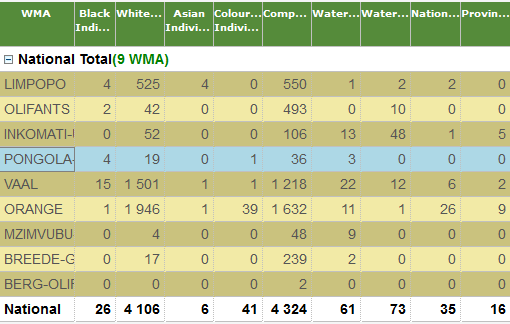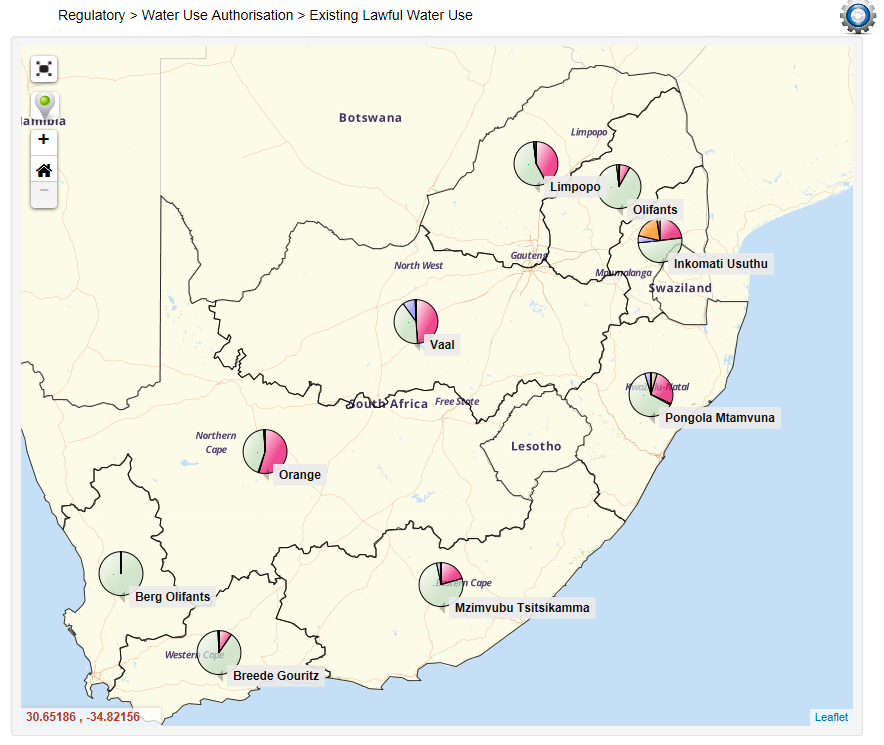Existing Lawful Water Use
-
What does this dashboard relate to:
This dashboard relates to “existing lawful water use” as an authorisation type. Existing lawful water use was a mechanism to bridge the gap between the old legislation and the new National Water Act (NWA). It was only intended as an interim measure to allow water use to continue until it can be converted to a licence.
An existing lawful water use is a water use that lawfully took place in the period two years before the commencement of the NWA. This allowed water use that lawfully took place to continue until such time as it can be converted into a licence. However, if you were not using water in the two years before the NWA was promulgated, but there was good reason why not, you can apply to have your water use declared as an existing water use. You can also apply to have the extent of your existing lawful water use verified at any stage, or the Department can ask you to apply for this verification. This process is undertaken in two stages namely:
- Validation- confirms how much water you were using in the two years prior to the promulgation of the NWA, and whether this was correctly registered.
- Verification- confirms if the water use in that period was lawful. The Department use a variety of techniques to do this including satellite and aerial photography, irrigation water use models, and interviews with the water users.
-
Person(s) who championed the dashboard:
-
Khutso Mabela, National Register of Water Use
-
Khutso Mabela, National Register of Water Use
-
Enquiries:
- For all dashboard enquiries click HERE to go to the Contact Us page.
-
What type/s of questions does the information product aim to answer
The dashboard provides statistics on water uses in a particular water management area that were:
- confirmed as existing lawful water use,
- declined as existing lawful water use, and
- Those that are still to be confirmed as existing lawful water use.
This assists the Department of Water and Sanitation to manage the water resources and ensure fair water allocation. Thus the dashboard is suited for planning and oversight roles.
-
Data / Information discussion:
-
Data used to generate the information
-
What data is used?
The WARMS database is used. The database in on DWS’s network and the server is located at DWS head office.
-
How is it extracted and from where?
Data is extracted using a Python script that connects to the WARMS database and executes a SQL query on the database, the filtered data is then copied to the temporary table in the NIWIS database before more processing is done on the data.
-
How often is it extracted?
Data is extracted monthly.
-
What data is used?
-
The algorithms / equations used to convert data into information:
Select all licenses where the status is not deleted and the finding_reason_id is 2, 9 or 11. Count the number of licenses per financial year per WMA and Nationally for the following categories: Total number of licenses, licenses awarded to individuals (per population group), licenses awarded to companies, licenses awarded to Water Services Providers, licenses awarded to Water User Associations, licenses awarded to National Departments, licenses awarded to Provincial Departments.


-
Data used to generate the information
-
Links to other sources of related information
-
Are there any limitations / cautions related to using this information?
The verification process of the data can take months to years.
Copyright: The copyright of the data/information remains with the Department of Water and Sanitation. This approval to use the data/information cannot be construed as a transfer of copyright.
Usage: All data is supplied free of charge and may not be sold to third parties. The use of information data is restricted to use for academic, research or personal purposes.
Quality: All data is supplied with no expressed or implied warranty as to its suitability for purpose, accuracy or completeness.
Status: Meanwhile data is continuously updated; the data set(s) supplied are already historical on the day of supply.
Acknowledgement: Whenever used in publications or the electronic media, the Department Water and Sanitation is to be mentioned as the proprietor of the relevant copyright.


